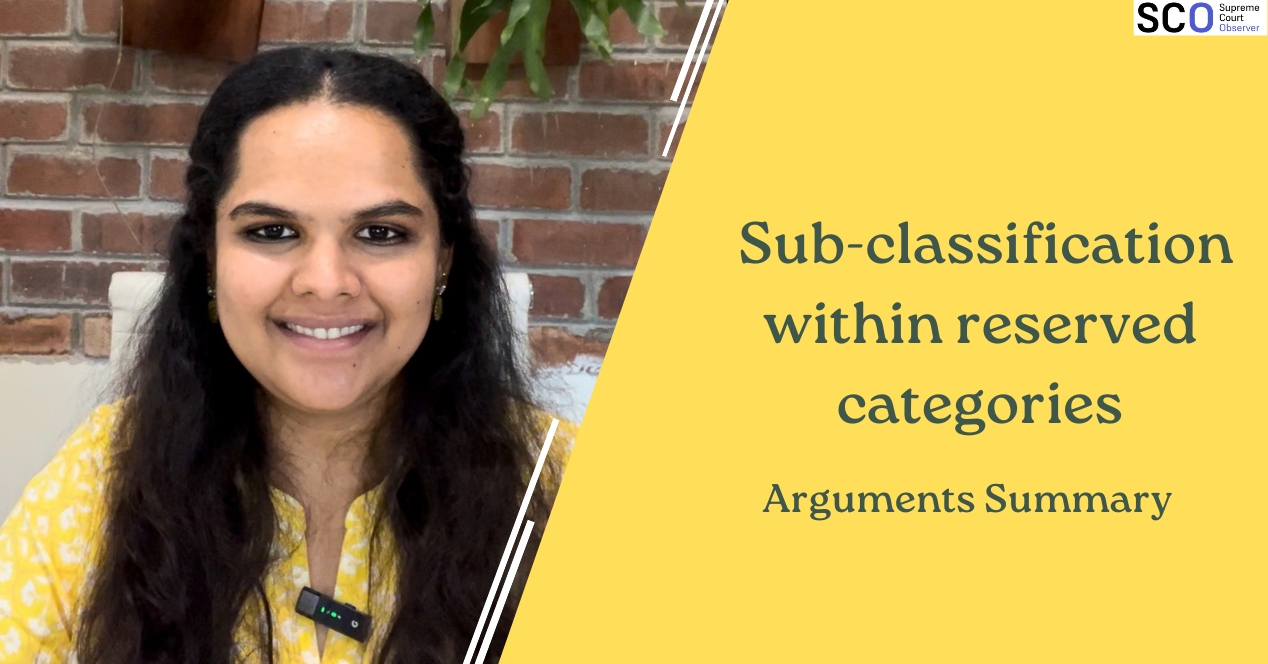Channel
Sub-classification within reserved categories: Judgement explainer
We breakdown key findings and observations of the Supreme Court's decision to uphold sub-classification within the reserved categories
Transcript:
Hello everyone and welcome to SCO’s channel!
I’m Sai Spandana and today we’ll be talking about a recent Supreme Court decision which upheld the validity of sub-classification within the reserved SC/ST categories. This judgement has dominated the news cycle and is a critical step in the affirmative action discourse in our country.
The decision was delivered on 1 August 2024, nearly six months after arguments in the case had concluded. A seven judge Constitution Bench of the Court, in a 6:1 majority, overruled the Court’s five judge bench decision in E.V. Chinnaiah v State of Andhra Pradesh in 2004. Six of the seven judges on the bench wrote different opinions, with one judge dissenting from the majority’s view.
The Chief Justice wrote on behalf of himself and Justice Manoj Misra. Justices B.R. Gavai and Pankaj Mithal authored separate concurring opinions. Justices Vikram Nath and S.C. Sharma authored opinions agreeing with the Chief and Justice Gavai’s opinions. Justice Bela Trivedi wrote the sole dissenting opinion in the case.
In this video, we break down the key findings and observations of the bench in the 565-page judgement. Let’s dive in!
The first question before the bench was to identify if Article 14 prohibits or permits sub-classification within the reserved groups. Article 14 states that the state shall not deny to any person equality before the law or equal protection of the laws within the territory of India.
Respondents in the case had argued that creating subclassifications within the reserved category was a violation of the equal protection of laws for castes within this category. The majority rejected this train of argument and held that sub-classification was permissible under Article 14. This article, they said, promoted parity of treatment under parity of circumstances, not sameness.
There was disparity amongst the various castes within the Scheduled Caste group, and therefore, sub-classification within this group was valid, as it tackles this facet of inequality. In her dissenting opinion, Justice Bela Trivedi held that sub-classification was in fact violative of Article 14, as it deprives other castes in the Presidential list from the benefit of reservation.
Speaking of the Presidential list of 1950, this is a list of state-wise Scheduled Castes notified by the President under Article 341 in 1950. The question before the bench was whether inclusion under this list meant that the Scheduled Castes were a homogeneous group. Respondents had argued in the affirmative, and therefore asserted that sub-classification within this group was not permissible.
This was also the view adopted by the bench in E.V. Chinnaiah in 2004. Various state governments and the Union Government, on the other hand, had taken the opposite stance. They said that the Scheduled Castes were not a homogeneous group, as they were marked by varying levels of discrimination and backwardness.
The majority overruled the decision in Chinnaiah and held that mere inclusion under the Presidential list of 1950 was not a mark of homogeneity amongst the Scheduled Castes. Justice Bela Trivedi, in her dissent, stated that the Scheduled Castes, as notified by the President, were an amalgam of castes, races, groups, tribes, communities, or parts and therefore were a homogeneous group.
In E.V. Chinnaiah, the court had held that creating sub-classification would amount to tinkering with the Presidential list. Therefore, it was impermissible because only the President could notify castes under Article 341 and only Parliament had the power to include or exclude castes from this list.
In this regard, the bench in Chinnaiah had also held that state governments do not have the power to create sub-classification. Overruling this, the majority held that subclassification did not involve including or excluding castes from the Presidential list.
Rather, it was only giving preference in reservation to certain castes within the list who were most backward. Therefore, it did not amount to tinkering with the list. Further, the majority also held that state governments could create sub-classification.
Justice Bela Trivedi in her dissent, however, held that even though sub-classification did not per se amount to inclusion or exclusion from the Presidential list, it would in fact still amount to tinkering with it.
She also said that state governments could not create such sub-classification because no entry in the state or concurrent lists allowed them to do so.
In 1992, in Indra Sawhney v. Union of India, a nine judge bench had recognised sub-classification within the Other Backward Classes group.
Relying on this, the states and Union Government had argued that similar sub-classification could be extended to the Scheduled Caste and Scheduled Tribes group also.
The respondents, however, had argued that the decision in Indra Sawhney was restricted to Other Backward Classes and could not be extended to Scheduled Castes and Scheduled Tribes.
The bench in that case, they said, had categorically left the SC/ST groups out. But putting the debate to rest finally, the seven-judge bench clarified that the only reason that the court in Indra Sawhney had excluded Scheduled Castes and Scheduled Tribes was simply because the facts of that case pertained to Other Backward Classes, and not Scheduled Castes and Scheduled Tribes.
Justice Bela Trivedi disagreed. She said that the bench in Indra Sawhney categorically excluded Scheduled Castes and Scheduled Tribes, and therefore they could not be sub-classified.
The majority in this case held that any sub-classification must be made based on empirical data proving social backwardness within the SC/ST groups.
They also stated that any law which creates sub-classification was subject to judicial review, meaning that it can be challenged in the court of law.
The bench also made it clear that a law creating sub-classification can give certain castes preferential treatment, but could not have the effect of excluding any castes within the list from the benefit of reservation altogether.
The “creamy layer” refers to those members of a backward class who are highly advanced socially as well as economically and educationally. In Indra Sawhney, the court had held that the creamy layer within the OBC groups could be excluded from the benefit of reservation.
In the present case, Justice B.R. Gavai, in his judgement, observed that the creamy layer exclusion could be extended to the SC/ST group as well, but the criteria to identify them had to be different from that which applied to OBCs. Justices Vikram Nath, S.C. Sharma, and Pankaj Mithal concurred with him.
This observation has sparked much debate since. Several commentators pointed out that extending the creamy layer to the SC/ST groups would be disastrous. Last week, the Union Cabinet, led by Prime Minister Narendra Modi, discussed the issue and asserted that the creamy layer exclusion would not apply to the Scheduled Caste and Scheduled Tribes group. However, it remains to be seen if Justice Gavai’s observation will bring new legitimacy to the larger creamy layer argument in upcoming cases.
This brings us to the end of this video. For a detailed breakdown of the judgement, check out our judgement summary. We’ve also laid out the opinions of each judge on each critical issue in an easy to read table, or as we call it, our judgement matrix. So do check it out. Not just this, we’ve also curated a list of five articles you should read on the Supreme Court’s decision to allow states to create sub-classification within the reserved categories. Do read that as well. Also tell us what you think about the sub-classification question in the comments below.
As always, for more stories from the Supreme Court, stay tuned to scobserver.in!




